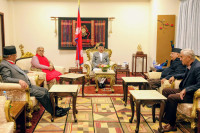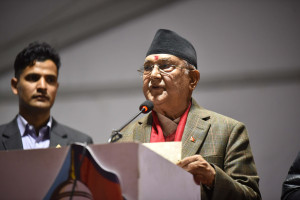Editorial
Power sans responsibility
Rather than a sense of security, the presence of the police strikes fear in people’s hearts.
The brutal thrashing of a doctor who was walking home after finishing his shift has brought forth public claims that a repressive mindset is still operational within the police force. Dr Kul Bahadur Ghishing was viciously attacked on his way home from the hospital by a constable on the pretext that he had been walking at night. This is not the first case wherein the security apparatus has shown severe abuse of power. However, it is alarming that the confidence to act brazenly emerges possibly in the complete absence of training concerning the rights of citizens and the limitations of power accorded to the security apparatus.
Even if we are to consider this particular issue as a one-off wanton behaviour of an individual in uniform, the attitude displayed by the constable and the group of other policemen present at the scene clearly shows their ability to abuse the powers vested in them in the knowledge that there will be no severe repercussions. Or, on a bleaker note, one that is usually hidden from the public eye—such abuse of power is often left unaddressed, which is taken as tacit approval by those lower down the security apparatus that is in constant touch with the public.
Cases of police brutality are a common occurrence in Nepal. Baton charging and physical violence at demonstrations are often justified to control the protestors. Such events quickly spiral out of control with the presence of armed police who resort to using guns, which tends to aggravate the situation by adding fuel to the fire. And instead of reaching an amicable end, demonstrations, more often than not, result in more deaths and suffering. Instead of inculcating a sense of security among the public, the presence of the police strikes unnecessary fear in people’s hearts; this ongoing image makeover has no other design than to inculcate fear among the ordinary populace.
Another matter of concern is the rising incidences of custodial death in Nepal. As we recently witnessed in the case of Sundar Harijan, who is alleged to have hanged himself. Despite concerns from the United Nations and domestic and international human rights organisations, custodial deaths in Nepal have continued with little progress in investigating them. Ignoring such matters does little in projecting the image of the police force as benevolent. And the authorities have done precious little to ensure investigation at the earliest.
Redefining the image that projects the police as a brutal force leads to nothing but the erosion of trust between the public and the security apparatus, which will undoubtedly have graver consequences for the state’s security as a whole if the trust deficit is allowed to widen. There needs to be an instant overhauling of the training practices and procedures to ensure that those assigned to protect the public do not violate their power and responsibility in carrying out their duties. No impunity should be granted to those that stand to abuse the trust accorded in good faith.




 16.12°C Kathmandu
16.12°C Kathmandu














